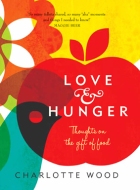 Many years ago my sister-in-law Jacqui from Tassie made me the best apron I’ve ever owned. So much a part of our lives was it, this heavy cotton lime-green apron even scored a mention in the best woman’s speech at our wedding nearly seven years ago, as some kind of symbol of how we live (code, basically, for Pair of Gluttons).
Many years ago my sister-in-law Jacqui from Tassie made me the best apron I’ve ever owned. So much a part of our lives was it, this heavy cotton lime-green apron even scored a mention in the best woman’s speech at our wedding nearly seven years ago, as some kind of symbol of how we live (code, basically, for Pair of Gluttons).
Last week, the neck strap on this faithful friend (not the one pictured here, but similar) finally gave way, coming apart in my hands. And my elegant solution – tying a knot in it – ended up creating an unfortunate noose-like effect.
Luckily, I had to hand my first understudy apron, given me as a kitchen-warming present by the Parsnip Princess last year. This rather glamorous, intricately patterned number is especially good for hiding the many splotches and blobs that inevitably end up all over me, and also – having been made by some hardworking Kenyan gals – has the added benefit of the humanitarian glow one gets from wearing.
Then, later in the week, I was very thrilled when Charlotte Chicken’s foster grandmother Deb presented me with a perfect replacement for my old green faithful, that she picked up during the dreadful hardship of a trip round Spain and Italy recently.
All this led me to think about the essential qualities of the apron, and whether I am alone in obsessing about this. I am amazed by all those cooking TV shows where there’s nary an apron to be seen – how do they do it? What do they wipe their hands on? I have several half-aprons, but find the classic coverall shape the best for my particular style, which tends to the slip-slop-slap. And I am keen to hear from you, dear howtoshuck family, about your criteria for the perfect apron. Do you, indeed, even use one? If you do, what’s your favourite type? Do you have views on length and width? Are pockets essential? Are you a fan of those cute retro half-pinnies? What about strings and straps – adjustable, or no? Front-fastening, or back? Half or full?
I await your advice. And then down the track we must do a companion piece on tea towels…

 Sunday lunch in winter is a very fine thing, and a big pot of shellfish stew has gotta be up there as one of the easiest ways to make it happen. I don’t think I’ve ever made a proper bouillabaisse according to a recipe, but over the years various versions of this fishy number have made their way to our table.
Sunday lunch in winter is a very fine thing, and a big pot of shellfish stew has gotta be up there as one of the easiest ways to make it happen. I don’t think I’ve ever made a proper bouillabaisse according to a recipe, but over the years various versions of this fishy number have made their way to our table. Peel & devein prawns, leaving tails on and setting aside the shells & heads.
Peel & devein prawns, leaving tails on and setting aside the shells & heads.
 This dish is great served with plain couscous (or rice) and steamed green beans.
This dish is great served with plain couscous (or rice) and steamed green beans. So! On my first day back at the post I wanted to share my newest infatuation –
So! On my first day back at the post I wanted to share my newest infatuation – 
